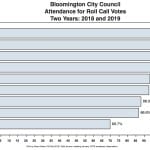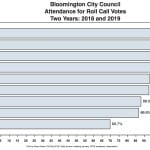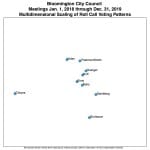Analysis | What 2 years worth of roll call votes confirm: 9 Democrats on Bloomington’s city council mostly agreed, but not always




Analyzing the raw statistics of roll call votes for Bloomington’s city council show that most of the time, the nine elected members of the local legislative branch are in agreement. It’s not a surprising result, given that they are all affiliated with the same party. They’re all Democrats.
A closer look at voting patterns might at first suggest that two departing councilmembers, Chris Sturbaum and Allison Chopra, could be outside the council’s mainstream of political thought, and separate from each other.
But factoring in attendance and a couple of isolated voting topics probably accounts for their apparent maverick status. They probably fit comfortably in the same corral as their fellow Democrats.
Of the 343 roll call votes counted by The Beacon over the last two years, 251 were unanimous. That’s 73 percent of them. That figure could fairly be critiqued as over-counting, because it treats as “unanimous” any roll calls where there zero votes against or zero votes for the question, including those where some members were absent or abstained from the vote.
For example, included in the count of “unanimous” votes was one taken on Dec. 19, 2018 on the rebuilding of the 4th Street parking structure. All six of the councilmembers who took a position voted also against the proposal. But councilmembers Jim Sims and Susan Sandberg abstained. Chopra was absent.
Abstentions are customarily allowed for Bloomington city councilmembers. In the last two years councilmembers have abstained 48 times. But the city ordinance about meeting procedures of the Bloomington city council includes a provision that would allow any councilmember to insist that a colleague cast a vote:
If a member fails to vote upon any matter, any other member may raise the question and insist that the member either vote or state the reason for not voting and be excused.
In last six months, The Beacon has not seen a Bloomington city councilmember invoke that provision of the city code.
A statistical approach called multi-dimensional scaling can incorporate abstentions and absences, along with outright differences in votes, to give an idea of how similar voting behavior is among legislators.
The idea behind this approach is first to calculate the “distance” between every pair of legislators using their voting vectors—that is, their record of votes on every roll call. For the analyses shown below, a Yea was assigned a “1”; a Nay a “-1” and non-participation a “0”. Non-participation due to absence or abstention were both assigned a “0.” That gives a list of pairwise “distances” between legislators.
Imagine having a list of distances between every pair of nine cities. That’s not useful as a navigational tool. What’s needed is a way to convert those pairs of distances into a map—a two-dimensional plot with cities located on it. Multi-dimensional scaling is a way to transform the distance pairs into a map.
For Indiana’s General Assembly, this technique confirms common knowledge—that the legislature takes a lot of votes along party lines. The slight differences in the fairly tight clusters in the plots for the state legislature probably aren’t as interesting as situations where a couple of “mavericks” emerge:

On the Republican side, at least some of maverick patterns can probably be chalked up to a House rule: The Speaker of the House isn’t required to vote on every roll call. And every non-participation in a vote puts a member an incrementally greater distance away from every other member of the House, no matter how those members voted.
The other scenario than can create greater separation between one legislator and others who generally vote the same is when that one legislator is the sole dissenter or the sole advocate on an issue.
Both scenarios—frequency of absence and occasional status as the “cheese that stands alone”—probably help explain apparent mavericks on the Bloomington city council, Chopra and Sturbaum, in this plot of roll call votes in 2018 and 2019. They are farther away from the other seven councilmembers, while also still well separated from each other:

The voting tallies used by The Beacon for these analyses aren’t official city records. They were compiled from meeting minutes, CATS video and observation. Why not analyze all four years of the term that concludes at the end of this year? Councilmember Tim Mayer resigned in 2017 as a member-at-large representative and was replaced by Jim Sims. So 2018 and 2019 made up the longest complete-year record of votes for the edition of the council that concluded its term in 2019.
For anyone who followed the city council closely this year, it’s probably not surprising that Chopra’s percentage of participation in roll call votes was the lowest among councilmembers for the last two years.
Chopra’s roll call attendance for the last two years was just under 70 percent. For the last year it was around 55 percent. Many of her absences came on nights other than Wednesdays, when the council had, by majority vote, decided to schedule its consideration of the unified development ordinance (UDO).
At the city council’s Dec. 4 meeting, Chopra commented on her absences. She attributed some of them to the practical matters of her family obligations. Others she attributed to her protest of the frequency and the length of council meetings.

Sturbaum’s percentage of participation in roll calls was second lowest, after Chopra’s. But it was just a point or so off from Granger’s percentage. So Sturbaum’s separation from the rest of the herd can’t be explained just by appealing to attendance.
One possible place to look is votes where Sturbaum was the sole vote in favor of a proposition.
Over the past two years, for the seven roll call votes where a single councilmember voted in favor, four times it was Sturbaum who was the sole advocate for the proposition. On two occasions, his was the lone voice in favor of amendments to the transportation plan, which was handled in May of 2019. On two occasions, Sturbaum’s vote was the only vote in favor for amendments to the unified development ordinance, which the council handled from late October through early December.
There was at least one other amendment to the UDO that was put forward by Sturbaum, which got support from just one of Sturbaum’s colleagues.
The flip side of being the sole advocate for a proposal is being the sole voice of dissent. Of the 32 roll calls where just one councilmember dissented, Chopra was the sole dissenter for 15 for those votes, that is, almost half the time.
Seven of the roll call votes when Chopra’s was the sole voice of dissent, came at a single meeting in late July, all on the topic of e-scooter legislation. The rest of the city council reversed itself on the question of allowing parking of scooters on sidewalks, after voting unanimously in support of the sidewalk prohibition earlier in the spring. She voted against all the amendments that night in protest over the reversal of the council’s decision.
Vote-by-vote scrutiny of the fewer than 100 non-unanimous roll calls over the last two years would probably give some finer-grained insights into policy differences among councilmembers.
Whatever those differences are, it’s statistically clear what their affiliation in one political party might already suggest: Policy differences on Bloomington’s city council for the last two years were not of the kind that allows for discernment of clear camps or factions on the council.
Bloomington’s city council will see four new members in 2020.
Getting better than a coarse, statistical understanding of Bloomington’s city council policy choices by the end of 2020 will require watching councilmembers, vote by vote, through the year.




Comments ()